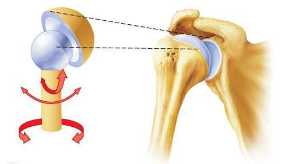Shoulder pain is super common. There are a few key factors that make the shoulder more susceptible to injury, in comparison to other joints in the body.
The shoulder has a huge range of motion:
- The shoulder is what we call a ball-and-socket type of joint. This means that the end of the upper arm bone (humerus) is like a “ball” that fits inside the “socket” of the shoulder blade (scapula).
- The ball-and-socket type of joint allows the arm to move in multiple planes of motion. In order to allow a high degree of mobility, the bony socket of the scapula is very shallow. Non-bony structures including the joint labrum, joint capsule, ligaments, and muscles act to deepen the socket and hold the humerus in place on the scapula.
- Having a high level of mobility in the shoulder means that stability is compromised. The shoulder is arguably the most mobile and least stable joint in the body. This high degree of mobility may result in shoulder injuries.
There are three types of injuries we often see in the shoulder:
- The overuse-type injury: the shoulder gets worn out over time as a result of ongoing “use and abuse”. This is typical of throwing athletes, or of people with jobs that require a lot of pushing, pulling, lifting or reaching.
- The traumatic-type injury: a high force such as a fall, pull or twist results in damage to the shoulder.
- The combination-type injury: there is ongoing “degeneration” in the shoulder that makes it weaker and more prone to injury. The person may or may not notice any problem in the shoulder, before an incident results in more severe injury.
The Rotator Cuff:
- The rotator cuff is made up of 4 small muscles that come off of the scapula and attach onto the top end of the humerus. These muscles help to hold the “ball” of the humerus onto the “socket” of the scapula. They provide stability to the shoulder and act to rotate the arm.
- The rotator cuff muscles are quite susceptible to degeneration with ongoing overuse, and are prone to partial or complete tearing when an injury is sustained to the shoulder.
Ellen Hosford MScPT Student

